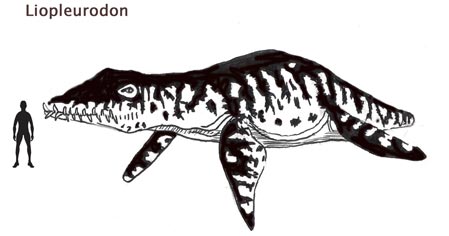Pliosaur Fossil Lurking in Garden Shed
Suffolk Man Finds Out About Pliosaur Fossils at the Bottom of His Garden
It pays to keep a sharp look out when working in the garden, as you never know what might turn up when digging. For example, a strange object discovered in 1997 when builders were digging a trench in the garden of Suffolk resident John Lambert, has turned out to be a fossilised bone from a giant, carnivorous marine reptile.
The village of Tuddenham St Martin, approximately two miles north-east of Ipswich (in the county of Suffolk, East Anglia, UK), may have had very little in common with the Jurassic coast until now and John remained unaware of the significance of his discovery until he took it along to the Colchester and Ipswich Museum to have it examined some sixteen years after the unusually shaped object was found.
Pliosaur Fossil
Mr Lambert, a retired banker, had thought his discovery might have been something very exciting, but he just never got round to getting the specimen checked over by a fossil expert, that was, until last month. The fossil is most probably a humerus (upper arm bone) from a large type of marine reptile known as a pliosaur. It is not possible to identify the genus from a single bone such as this, but one thing is for sure, it was a large animal for the bone measures 42 centimetres in length.
Pliosaurs, otherwise known as short-necked plesiosaurs had large skulls and enormous jaws armed with long, triangular or conical teeth. They propelled their streamlined bodies through the water using four paddle-like limbs. Just how big some of these pliosaurs could have been is open to speculation, although recent discoveries such as the Svalbard specimen, or the remains of the jaws and skull of pliosaur found in Dorset indicate that some species could have grown to lengths easily in excess of fifteen metres.
These creatures had their heyday in the Jurassic, survived into the Cretaceous but become increasingly rare in the fossil record towards the end of the Mesozoic.
An Illustration of a Typical Jurassic Pliosaur
Picture credit: Everything Dinosaur
Liopleurodon
The genus known as Liopleurodon (the name means “smooth-sided tooth”), is illustrated in the picture above. It has the typically massive jaws and powerful flippers of this family of reptiles. Some of the teeth in the lower jaw measured nearly twice the size of an adult T. rex tooth. A number of scientists have estimated that these creatures may have had some of the strongest bites of any known vertebrate.
Ann Ainsworth, assistant curator of natural history at the Colchester and Ipswich Museum, commented that the fossil was in very good condition, however, she stated:
“Marine reptiles are not animals you would expect to find as fossils in Suffolk as the local rocks are not the right age.”
So the question is, how did the fossil end up buried in a Suffolk garden?
Ann has suggested that the fossil “could have been collected by someone else previously and left in the garden.”
This is very plausible, as fossils do turn up in some very strange places. For instance, last year Everything Dinosaur wrote a short blog article about a Frenchman who discovered a dinosaur’s foot bone in his garden. Back in 2011, Everything Dinosaur reported on the discovery of an iguanodontid dinosaur bone turning up in Sunderland (north-east England).
To read more about the Sunderland fossil find: Strange Place to Find a Dinosaur Bone.
A Result of Deposition
Another explanation put forward by the researchers at the museum and one that Everything Dinosaur team members happen to agree with, is that this fossil find is as a result of re-deposition. Re-deposition occurs when strata which contains fossils is disturbed and the fossils end up being moved from the location where they were originally sited. Much of East Anglia has deposits of glacial clays, the result of movements of ice sheets during the Quaternary. In 1959, isolated fossils believed to have come from another Pliosaur were discovered in a ploughed field close to the village of Wrentham on the Suffolk coast. Four years ago, a single dorsal vertebra was found at Theberton Airfield about twenty miles north-east of Tuddenham St Martin.
A spokes person from Everything Dinosaur commented:
“It is quite likely that this particular fossil originates from Lower Jurassic deposits which can be found elsewhere in England. Lower Jurassic strata forms a narrow belt along the western margins of the Yorkshire Wolds continuing into Lincolnshire and into the Midlands. One of our team members once spotted a plesiosaur limb bone that had been exposed as a pond dried up. It is quite likely that this fossil bone originated from this Jurassic aged strata.”
Speaking about his lucky fossil find, Mr Lambert exclaimed:
“It’s rather fun. I’ve been here 29 years, we’ve got eight acres of ground, we are quite keen on the gardening side and I can honestly say we’ve found nothing whatsoever of any kind of value apart from rubbish, so it’s really fun to have found this.”
It is likely that the fossil will be donated to the Colchester and Ipswich Museum, it may not be part of the geology of Suffolk, but thanks most likely to glaciation and re-deposition, evidence of an apex Jurassic marine predator has been uncovered in a sleepy Suffolk village.
To view the range of prehistoric animal marine reptile models including plesiosaurs and pliosaurs in stock at Everything Dinosaur: Sea Monsters and Models of Marine Reptiles.


